An Epicurean Adventure: Discovering Flammkuchen, France’s Rustic “Flame Cake”
A Culinary Journey to the Heart of Alsace for an Authentic French-German Pizza Experience
Prepare to embark on a delightful culinary journey to the charming Alsace region, nestled on the French-German border, where a unique and utterly delicious dish known as Flammkuchen (or Tarte Flambée) awaits. Far from your typical Italian-style pizza, Flammkuchen offers a distinctive spin on this beloved comfort food. Imagine a paper-thin, crispy crust – made without yeast for unparalleled crispness – generously topped with rich crème fraîche or sour cream, thinly sliced onions, and savory smoked bacon. This traditional Alsatian delicacy is not just a meal; it’s a testament to the rich cultural tapestry of its origin.
Our homemade Flammkuchen recipe elevates this rustic dish, featuring beautifully caramelized onions, succulent smoked bacon lardons, and a delicate scattering of nutty Gruyère cheese. It’s an exceptionally easy recipe to follow, requiring minimal preparation and quick baking, making it perfect for a weeknight dinner or an impressive appetizer. Best of all, its simple yet profound flavor profile is endlessly customizable, inviting you to experiment with your favorite toppings.
For those who love exploring unique pizza variations, you might also enjoy a visit to South Africa with this tantalizing bacon, avocado, and feta pizza, offering a fresh and vibrant alternative.

Fast Facts: A Glimpse into France and the Alsace Region
To truly appreciate Flammkuchen, it helps to understand the vibrant country and region from which it originates. France, a land renowned for its culinary excellence and rich history, provides the perfect backdrop for this iconic dish.

| Location | France is strategically located in Western Europe, sharing borders with a diverse array of countries including Belgium, Luxembourg, Germany, Switzerland, Italy, Spain, and Andorra. Its extensive coastlines touch the Mediterranean Sea, the Atlantic Ocean, and the English Channel, contributing to its varied geography and culinary traditions. |
| Language | The official language spoken throughout France is French, a Romance language deeply ingrained in global culture, diplomacy, and cuisine. |
| Population | With a vibrant population of approximately 67 million people, France is a major European nation, known for its cities, countryside, and cultural contributions. |
| Culinary Trivia | French people boast the highest per capita cheese consumption in the world. It’s no surprise then that a popular saying among the French is, “Life is too short to eat bad cheese!” This love for cheese undoubtedly influences dishes like Flammkuchen, where cheese, even sparingly used, plays a crucial role. |
What Exactly is Flammkuchen (Tarte Flambée)?
Flammkuchen, often referred to as Tarte Flambée in French, is a traditional and highly celebrated dish originating from the picturesque Alsace region of France. While firmly rooted in French culinary history, its popularity extends far beyond, captivating palates in neighboring Germany and Switzerland.
At first glance, Flammkuchen might resemble a thin-crust pizza. However, its defining characteristic lies in its exceptionally crispy, almost paper-thin crust. Unlike traditional pizza dough, Flammkuchen’s base is prepared without yeast, relying simply on flour, water, salt, and oil. This lack of yeast results in a remarkably delicate and brittle texture that sets it apart from its Italian cousin.
The traditional toppings for Flammkuchen are elegantly simple yet incredibly flavorful. They typically consist of a creamy spread of crème fraîche or sour cream, which provides a tangy base. This is then adorned with thinly sliced onions and savory strips of bacon or pancetta. The magic truly happens when it’s baked, traditionally in a super-hot, wood-fired oven, until the edges are beautifully charred and the toppings are perfectly cooked. Served piping hot and cut into rectangular slices, Flammkuchen offers a delightful balance of creamy, savory, and crispy textures.
The Rustic Origins of Flammkuchen: A Baker’s Ingenuity
The fascinating origin of Flammkuchen is steeped in a charming tale of practicality and culinary innovation, born from the simple needs of Alsatian bakers. Legend has it that this delightful “flame cake” was conceived out of a baker’s clever method for testing the heat of his traditional wood-fired oven before baking his daily loaves of bread.
In the days before thermometers, bakers relied on their senses and simple tests to ensure their ovens reached the optimal temperature. A common method involved spreading a thin layer of basic dough onto a wooden peel, topping it with a few readily available ingredients – typically cream, onions, and bacon – and then sliding it into the blistering hot oven. If this thin “pizza” crisped up and browned to perfection in a remarkably short amount of time, it was the ultimate sign: the oven was precisely at the right temperature, ready for the serious business of baking bread. If it took too long, more wood was added; if it burned too quickly, the oven was allowed to cool slightly.
Thus, Flammkuchen was born not as a deliberate culinary creation, but as a practical gauge for oven readiness. What started as a functional test quickly evolved into a beloved, delicious snack in its own right, savored by the bakers and their families. This humble origin story underscores the rustic charm and authentic character of Flammkuchen, a dish that truly reflects the resourceful spirit of Alsatian cuisine.
A Dish of Many Names: Regional Variations of Flammkuchen
The direct translation of Flammkuchen to English is ‘Flame Cake’, a fitting name given its traditional preparation in a fiercely hot, often wood-fired, oven. However, depending on where you are in the Franco-German border region, this beloved dish goes by a few other equally evocative names, each reflecting the local dialect and cultural nuances:
- Flammkuchen – Predominantly used in Alsace, France, and parts of Germany.
- Tarte Flambée – The French name, also widely used in Alsace, France, and neighboring German-speaking areas.
- Flammekueche – A variation commonly heard in Lorraine, France, showcasing the regional linguistic differences.
- Flamkuchen – Found in Rhineland-Palatinate, a German state bordering Alsace, indicating subtle spelling variations.
- Flammèkueche – Another regional French spelling variant, particularly in Moselle, France.
- Flammèch – The name used for this delicacy in Luxembourg, highlighting its cross-border appeal.
- Pflammkuchen – A less common, yet authentic, name found in Saarland, Germany, close to the French border.
Regardless of its name, the essence of the dish remains the same: a delightfully thin, crispy crust with creamy, savory toppings, embodying the rich culinary heritage of this unique European cross-cultural region.
Why You’ll Fall in Love with This Flammkuchen Recipe
There’s a reason Flammkuchen has garnered such a loyal following, and this particular recipe perfectly captures its irresistible appeal. Here’s what makes it an absolute must-try:
- Effortless Preparation: The simple, no-yeast dough means no waiting around for rising time. You can whip up this dough and have it ready to roll in minutes, making it ideal for busy schedules.
- A Symphony of Flavors: The combination of deeply smoked bacon lardons, the sweet complexity of caramelized onions, and the subtle, nutty tang of Gruyère cheese creates a harmonious blend that tantalizes the taste buds.
- Crispy Crust Perfection: For avid thin-crust pizza enthusiasts, this recipe is a dream come true. The ultra-thin base bakes to an unparalleled crispness, offering a satisfying crunch with every bite.
- Limitless Customization: While the traditional toppings are sublime, this Flammkuchen serves as a fantastic canvas for culinary creativity. Feel free to experiment with a vast array of topping combinations to suit any preference (see our suggestions below!).
- Accessible Ingredients: All components required for this recipe are simple, readily available, and likely already stocked in your pantry or easily found at your local grocery store.
This Flammkuchen recipe delivers on taste, texture, and ease, promising a delicious and rewarding cooking experience that brings the flavors of Alsace right to your kitchen.
Mastering Flammkuchen: Key Ingredient Notes and Smart Substitutions
Achieving the perfect Flammkuchen is all about understanding the role each ingredient plays and knowing when and how to make smart substitutions. Here’s a breakdown of the core components:
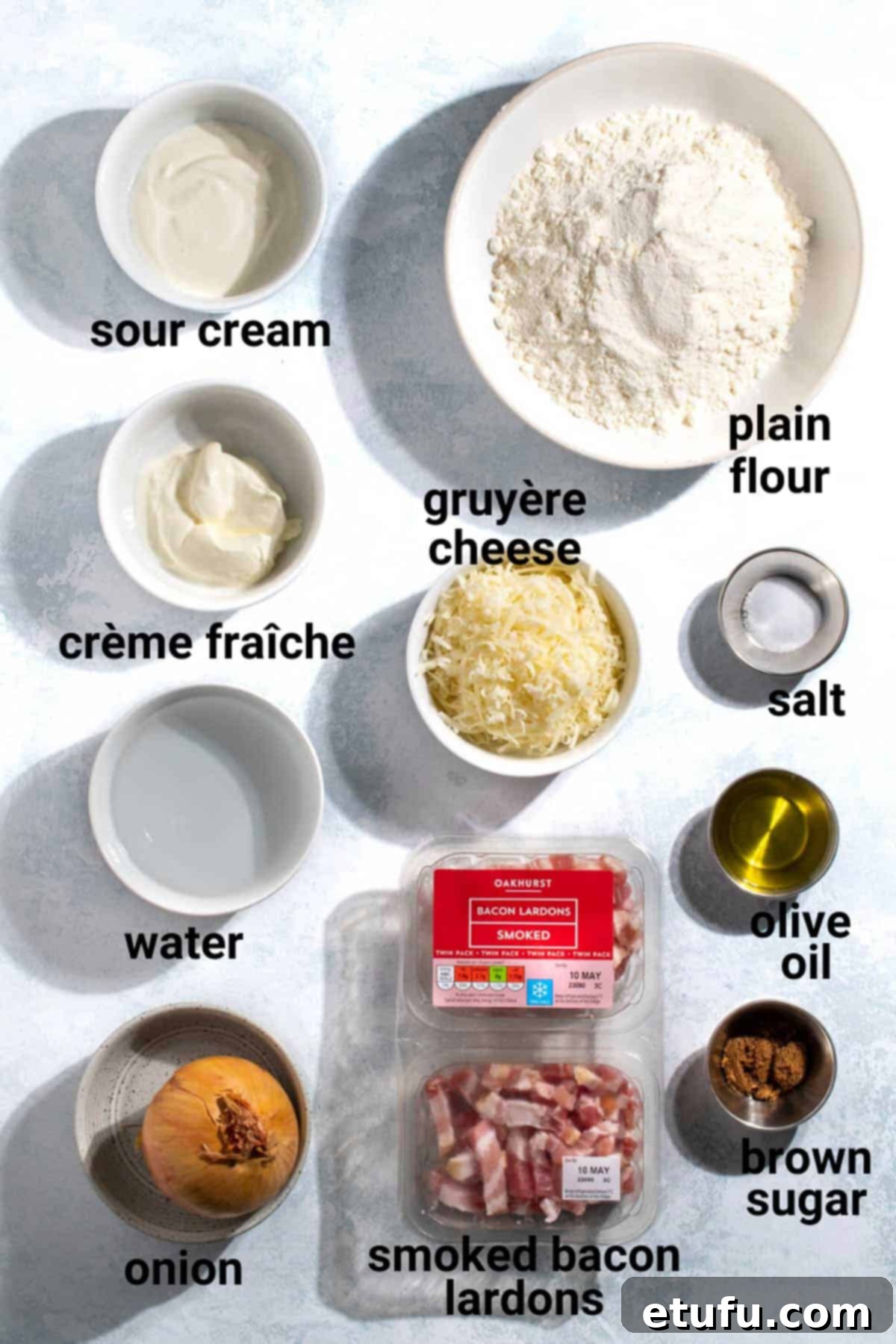
All-Purpose Flour: The Foundation of the Crust
Standard all-purpose flour forms the backbone of our thin, crispy Flammkuchen crust. Its versatility makes it ideal for achieving the desired delicate texture.
- Gluten-Free Option: For those with dietary restrictions, a 1-to-1 gluten-free flour blend can be seamlessly substituted for all-purpose flour, allowing everyone to enjoy this delightful dish.
Bacon: Adding Savory Depth
We absolutely adore using smoked bacon lardons for this recipe. Their pre-diced convenience saves time, and the intense smoky flavor they impart adds incredible depth to the overall taste profile, truly capturing the essence of traditional Flammkuchen.
- Substitution: If smoked bacon lardons are not readily available, feel free to use any type of bacon you prefer, simply cubing or dicing it into small pieces before frying. Pancetta also makes an excellent substitute for an even richer flavor.
Onions: The Sweet & Savory Star
The onions are a non-negotiable element, providing a crucial sweet and savory counterpoint to the bacon and cream. Whether you opt for red, brown, or white onions, the secret to achieving perfection lies in slicing them incredibly thin.
- Pro Tip for Thin Slicing: A mandoline slicer is your best friend here, ensuring uniform, paper-thin rings that caramelize beautifully. If you don’t have one, a very sharp knife and a steady hand will do the trick.
Brown Sugar: Enhancing Caramelization
A small touch of brown sugar added to the onions works wonders, aiding in their caramelization and bringing out a subtle sweetness that perfectly complements the savory components. This step creates a more complex and satisfying onion topping.
- Sugar-Free Alternative: If you’re avoiding sugar, you can certainly omit this step. The onions will still caramelize and become sweet on their own, albeit a little less intensely.
Crème Fraîche and Sour Cream: The Creamy Base
These two ingredients form the traditional, signature creamy spread for the Flammkuchen base, acting as a rich and tangy foundation instead of tomato sauce. If this is your first time trying Flammkuchen, you might find this unusual, but trust us, it’s incredibly delicious! The cream mostly absorbs into the crust during baking, contributing a subtle richness and moisture without overwhelming the other flavors.
- Substitutions: You can use all crème fraîche for a richer taste, or substitute sour cream with an equal amount of Greek yogurt for a slightly tangier and lighter alternative.
Gruyère Cheese: The Perfect Cheesy Accent
Gruyère is an absolutely fantastic cheese for Flammkuchen. The key here is restraint; you don’t want to overload this delicate pizza with too many toppings. Less is definitely more to allow the crispness of the crust to shine through.
- Why Gruyère?: Gruyère is a strong, flavorful cheese, similar to Parmesan, meaning a small amount goes a long way. It provides a wonderful cheesy punch without smothering the thin base or making it soggy during cooking.
- Alternatives: Emmental or Comté cheese can also be excellent choices, offering similar nutty and savory notes.
Fresh Greenery: A Final Flourish
While optional, adding fresh herbs at the end can brighten the dish and add a touch of aromatic elegance.
- Suggestions: Chopped chives are a classic choice, but fresh parsley or a sprinkle of finely chopped spring onions can also work beautifully. Or, simply enjoy it plain to savor the pure, rustic flavors.
Essential Equipment for Crafting Your Flammkuchen
Making Flammkuchen doesn’t require a professional kitchen, but having the right tools can make the process smoother and ensure a perfect result. Here’s a quick guide to the equipment you’ll need:
Kneading the Dough
The Flammkuchen dough needs to be well-kneaded to develop its elasticity, crucial for achieving that signature thin crust.
- Stand Mixer: If you own a stand mixer, simply attach the dough hook. This makes the kneading process effortless and consistent.
- By Hand: For those who prefer a more hands-on approach, the dough can easily be kneaded by hand on a lightly floured surface. It’s a rewarding process that allows you to truly feel the dough’s transformation.
Rolling Pin: Achieving the Perfect Thinness
A rolling pin is indispensable for stretching the dough out to its incredibly thin, delicate state.
- Rolling Pin with Thickness Guides: These are highly recommended for any baking endeavors, ensuring uniform thickness. They are particularly helpful for Flammkuchen, as consistency is key.
- Standard Rolling Pin: A regular rolling pin works perfectly fine. Be patient with the dough; it will initially spring back, but with persistent rolling, you’ll achieve the desired thinness. Lightly dust your work surface and rolling pin with flour to prevent sticking.
Baking Surface: For that Wood-Fired Crisp
The goal is to mimic the intense, even heat of a wood-fired oven to get a super crispy crust.
- Pizza Stone: If you have a pizza stone, now is the time to use it! Preheat it thoroughly in your oven for the best results.
- Large Baking Sheet: No pizza stone? No problem! A large, sturdy baking sheet that can accommodate the size of your rolled-out crust will work just as well.
- Mimicking a Pizza Stone: To achieve a similar effect to a pizza stone, place your baking tray in the oven as soon as you start preheating. This allows the tray to get incredibly hot, ensuring an immediate crisping of the crust when the Flammkuchen is slid onto it. Exercise extreme caution when handling a hot baking tray to avoid burns.
With these simple tools, you’re well-equipped to create an authentic and delicious Flammkuchen right in your home kitchen!
Crafting Authentic Flammkuchen: A Step-by-Step Guide
Creating this traditional French-German pizza is surprisingly straightforward. Follow these steps carefully to ensure a perfectly crispy crust and deliciously balanced toppings.
Step 1: Preparing the Flammkuchen Dough
The no-yeast dough is quick to prepare and requires no rising time, making this recipe a fantastic choice for a speedy meal.
- Preheat your oven to a scorching 240℃ (465℉ / Gas Mark 8). Crucially, place a large baking tray or pizza stone on the middle shelf of the oven to heat up along with it. A very hot surface is essential for a crispy crust.

- In the bowl of a stand mixer (with the dough hook attachment) or a large mixing bowl, combine the all-purpose flour and salt. Give them a quick stir to ensure they are well mixed.
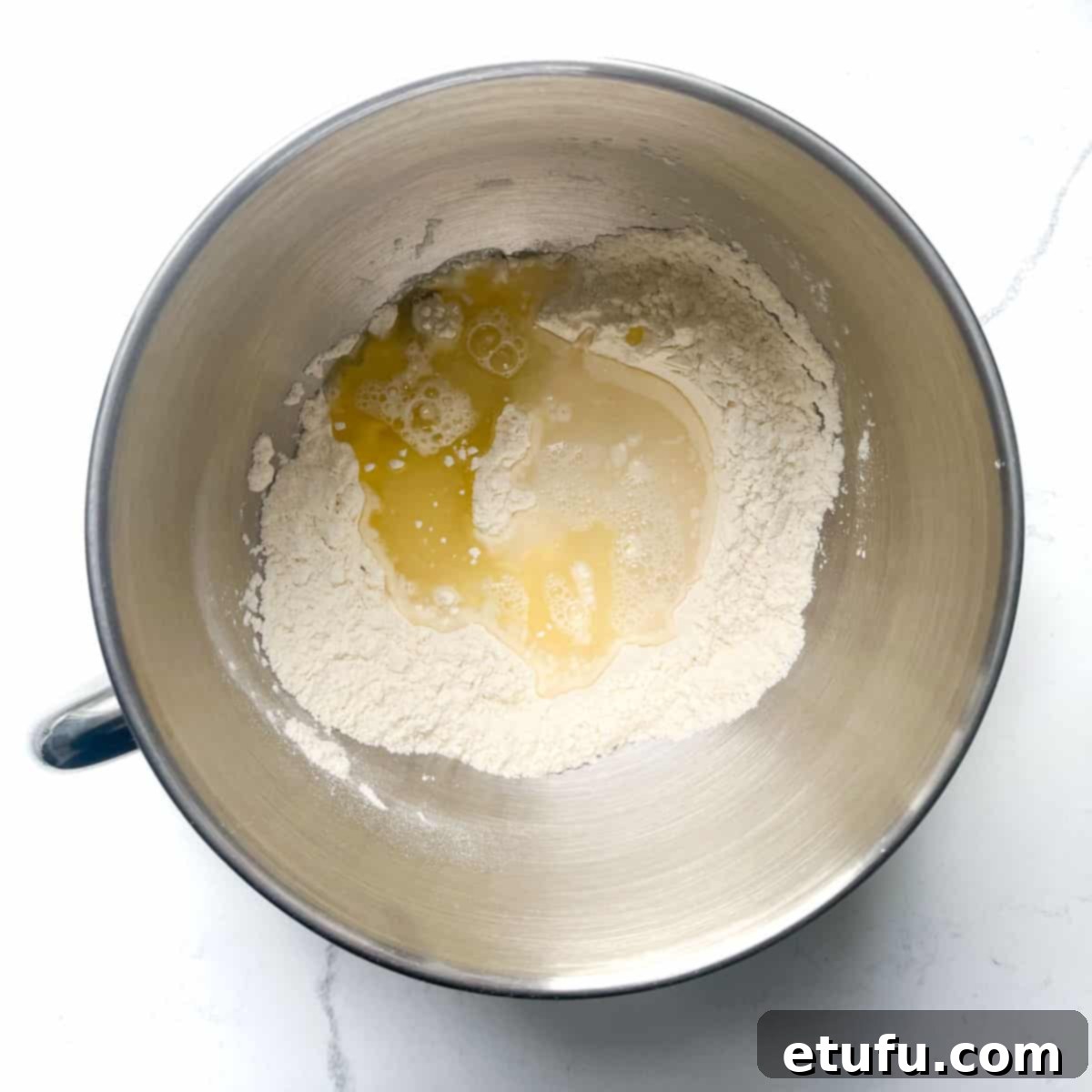
- Pour the warm water (ensure it’s just warm tap water, not boiling) and olive oil into the flour mixture.

- Using a sturdy spoon, briefly combine the ingredients until a shaggy dough forms.
- If using a stand mixer, attach the dough hook and knead the dough for **8-10 minutes** until it is smooth and elastic. If kneading by hand, continue for a good **10 minutes** on a lightly floured surface.
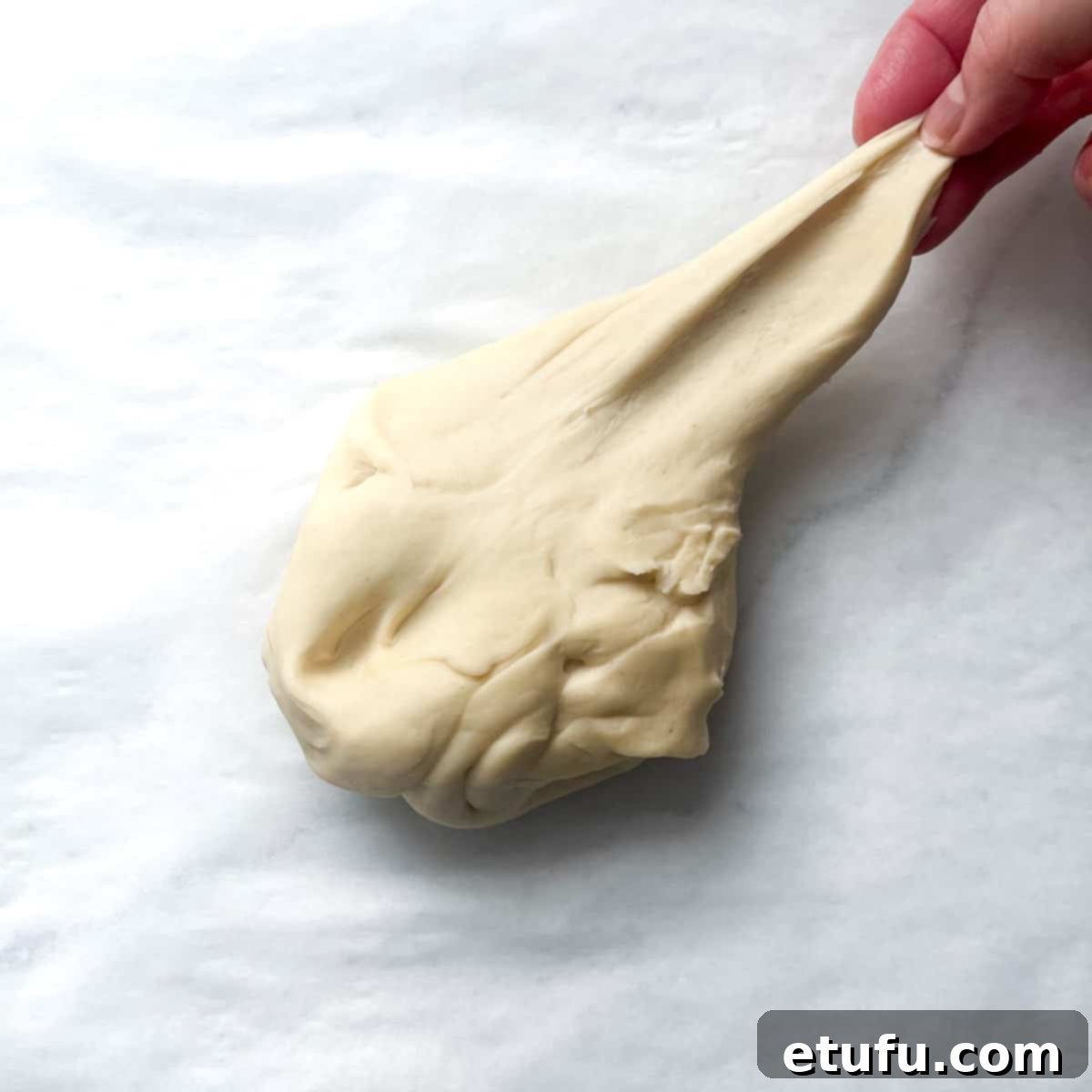
- You’ll know the dough is ready when it’s elastic, smooth to the touch, and springs back slightly when pressed.
- Cut a piece of parchment paper to match the size of your baking tray and lay it flat on your work surface. This will make transferring the thin dough much easier.

- Place the kneaded dough ball directly onto the parchment paper.
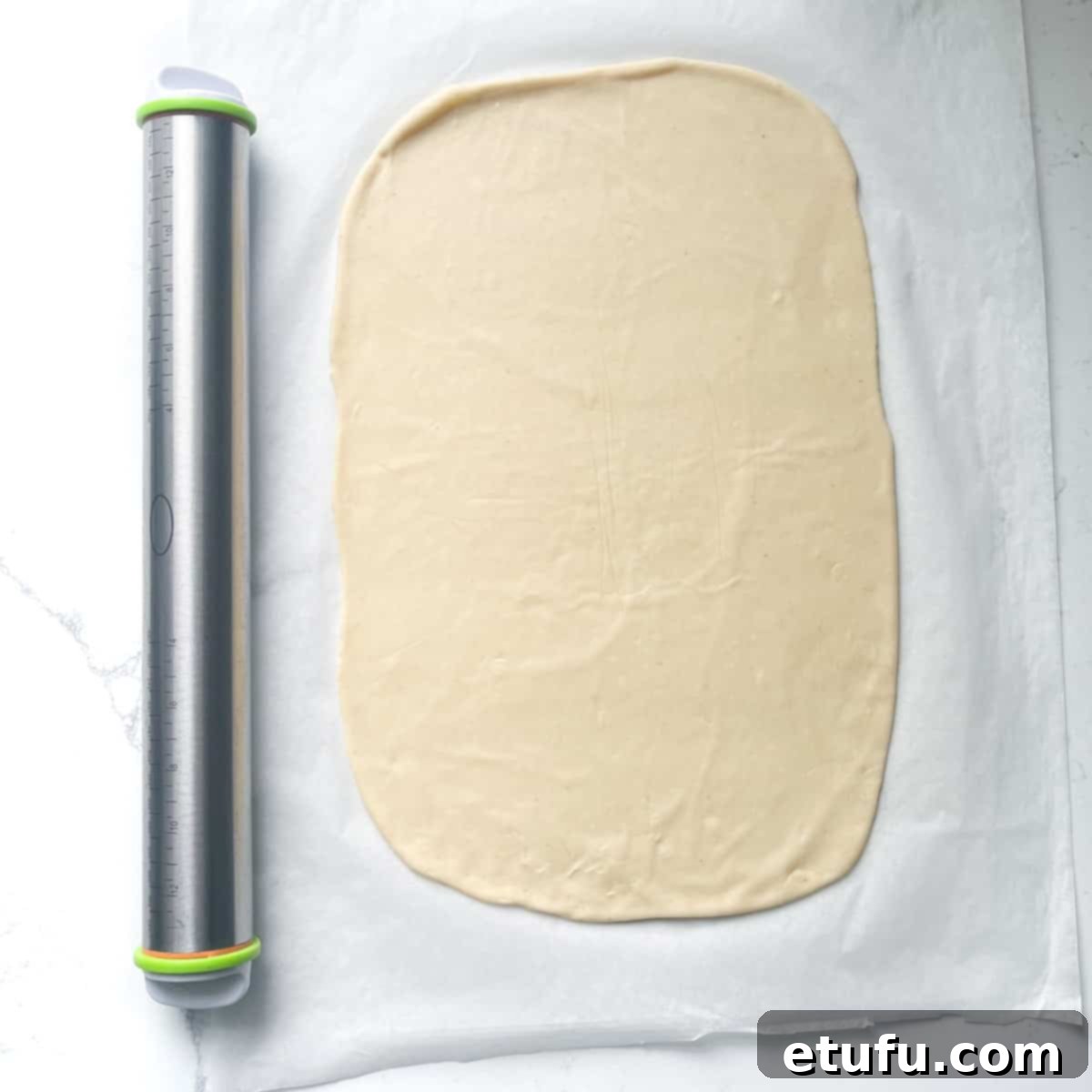
- Using a rolling pin, roll the dough out as thinly as possible, aiming for an oblong disc about **3mm to 5mm thick**. The thinner, the crisper!
Step 2: Preparing the Delicious Toppings
While your oven and dough are getting ready, prepare the classic Flammkuchen toppings to layer on your crispy base.

- Add the bacon lardons to a hot frying pan. Fry them briefly, just until they begin to brown and render some fat – about **2 minutes**. Be careful not to overcook them at this stage, as they will continue to crisp up in the oven.
- Remove the bacon lardons from the pan and set them aside.

- Slice your onion as thinly as humanly possible, ideally around **3mm**. This is crucial for its texture and caramelization.
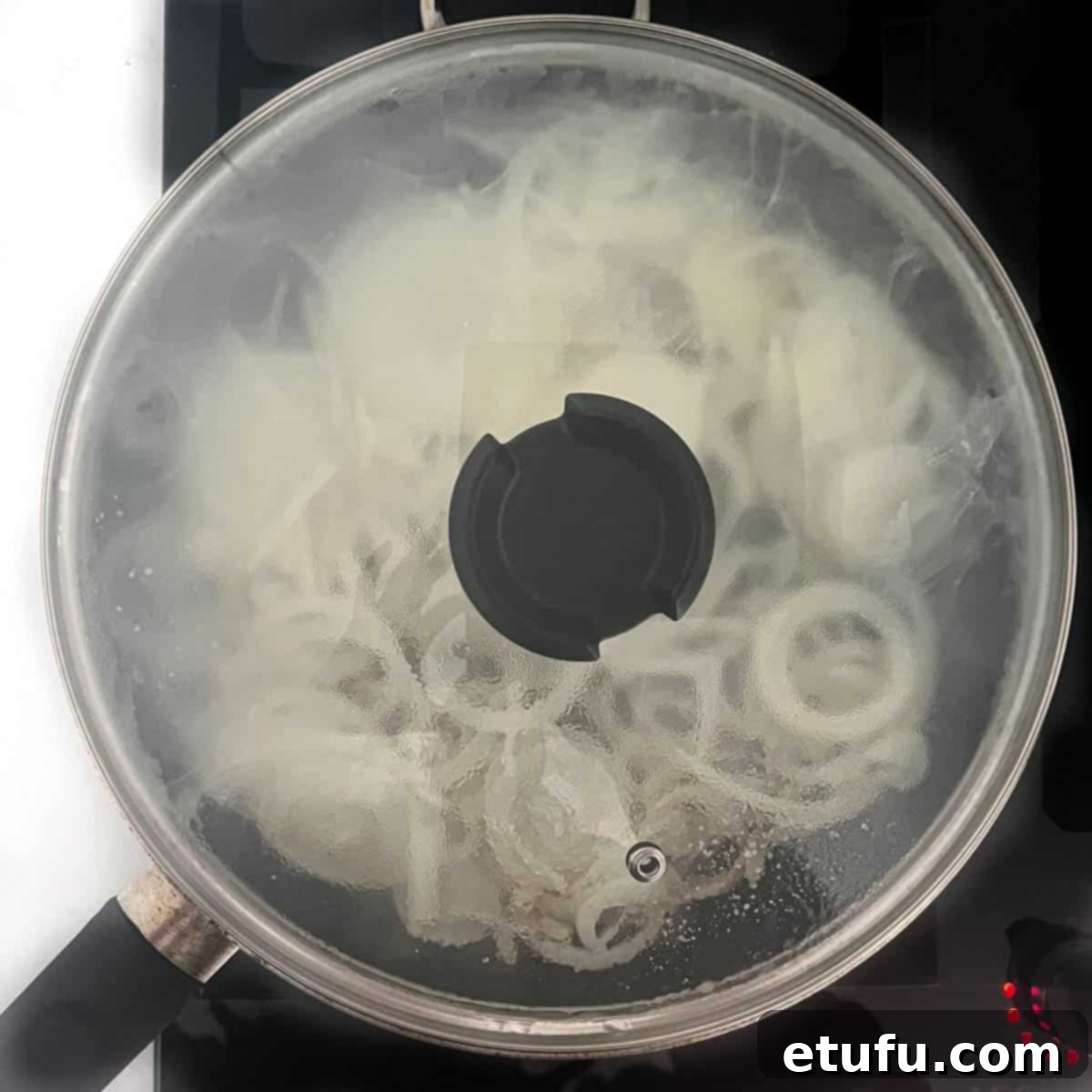
- In the same pan used for the bacon, add a dollop of butter (for richer flavor) or a dash of oil, along with the thinly sliced onion rings. Turn the heat to medium-low, cover with a lid, and allow the onions to soften for about **3-4 minutes**. Stir them every minute or so to prevent sticking.
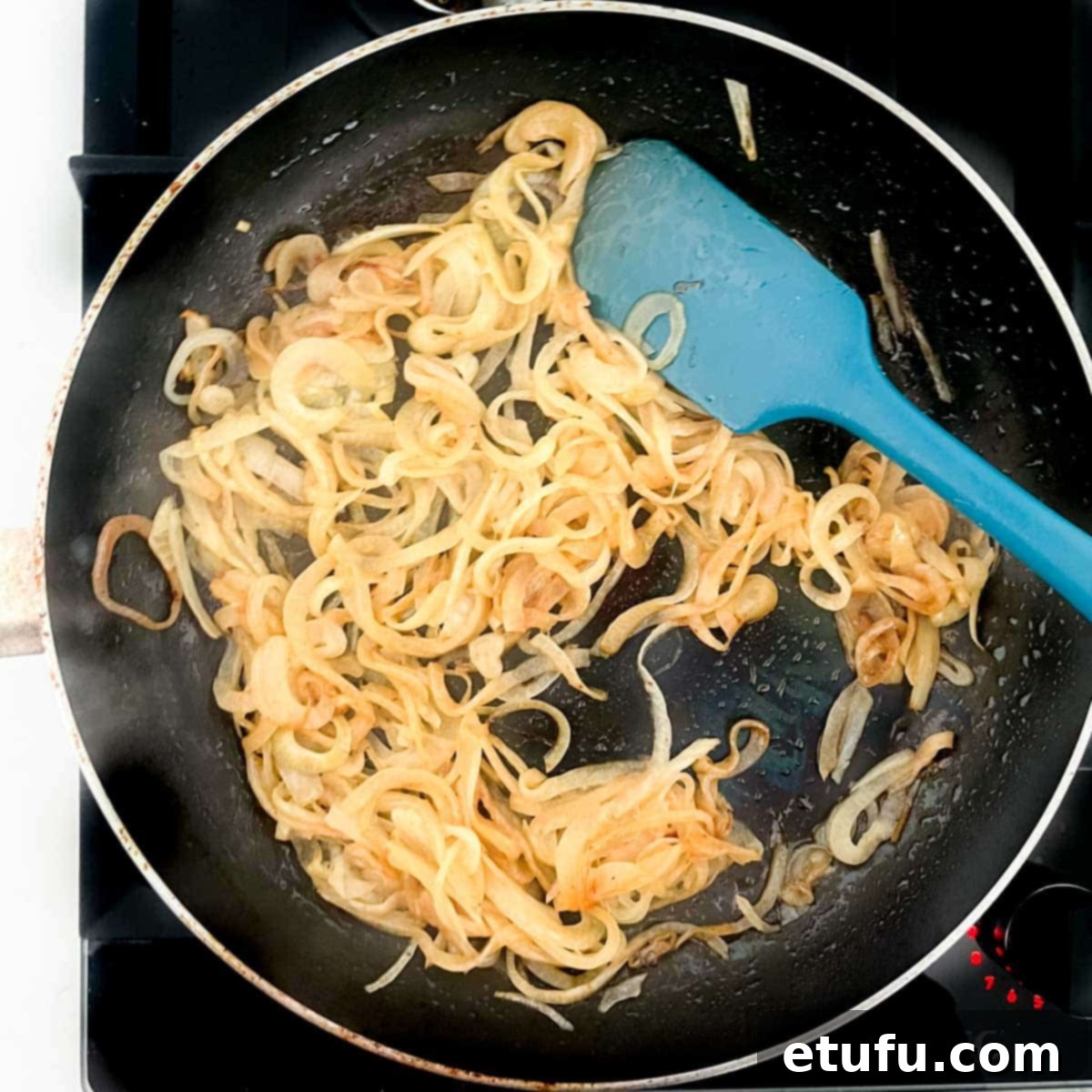
- Once the onions are soft, stir in a teaspoon of brown sugar. Continue to fry for a further **1-2 minutes** over medium heat, with the lid off, until the onions turn a beautiful light golden brown, becoming wonderfully soft and caramelized.
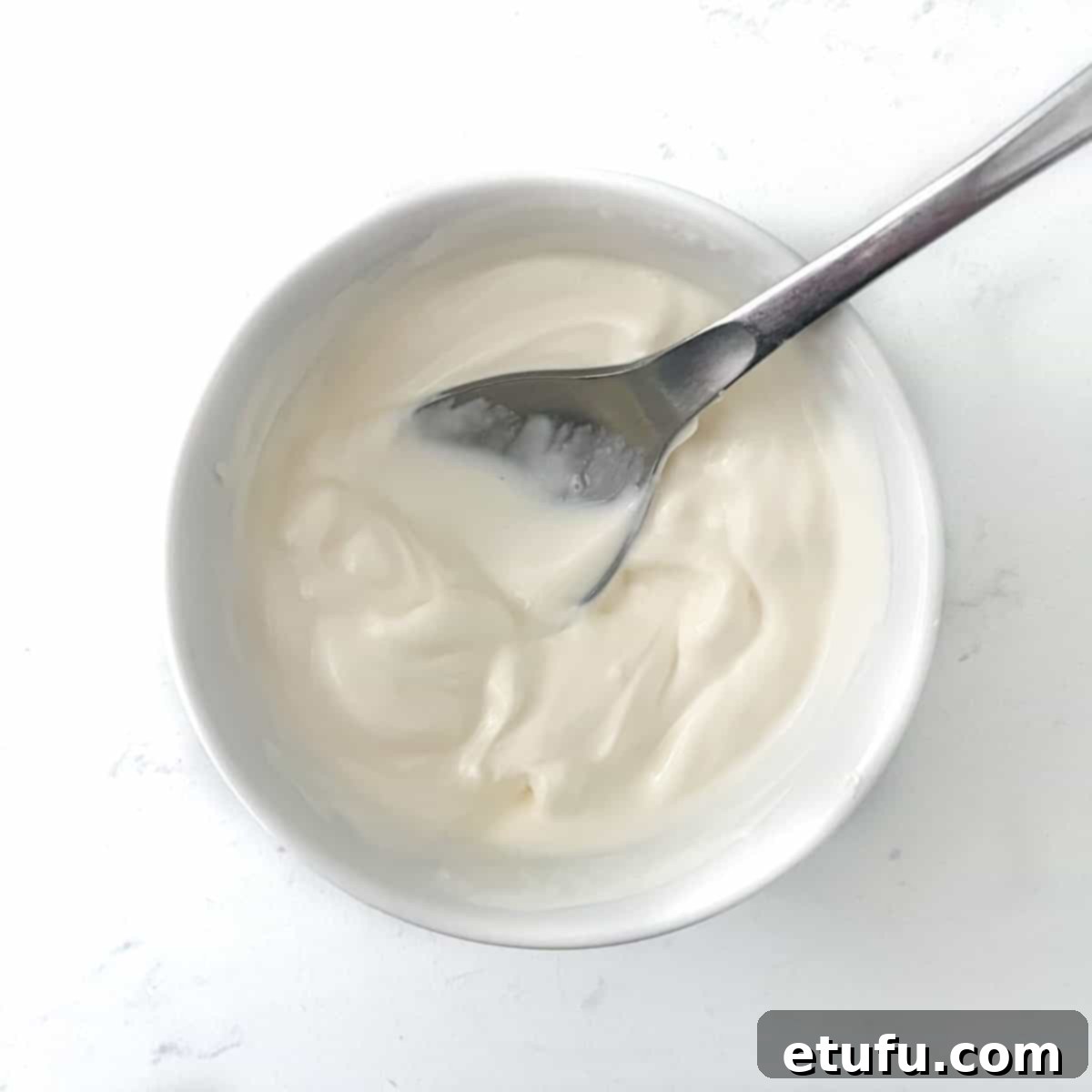
- In a small bowl, thoroughly mix together the crème fraîche and sour cream until smooth.

- Evenly spread the cream mixture across the surface of the rolled-out pizza dough, ensuring to leave a small border of approximately **1cm** from the edge to create a crust.
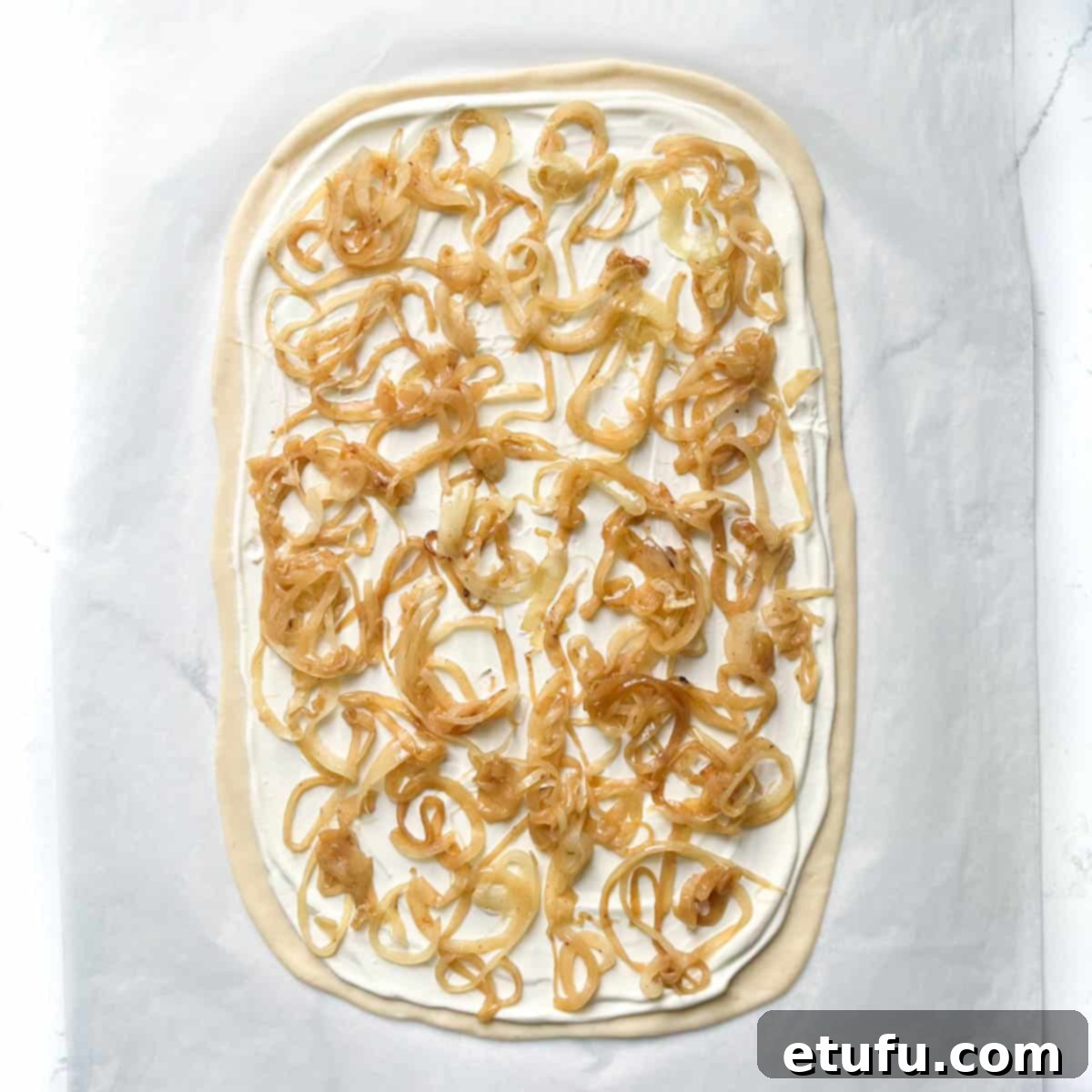
- Begin layering your toppings by evenly distributing the sweet caramelized onions over the cream base.
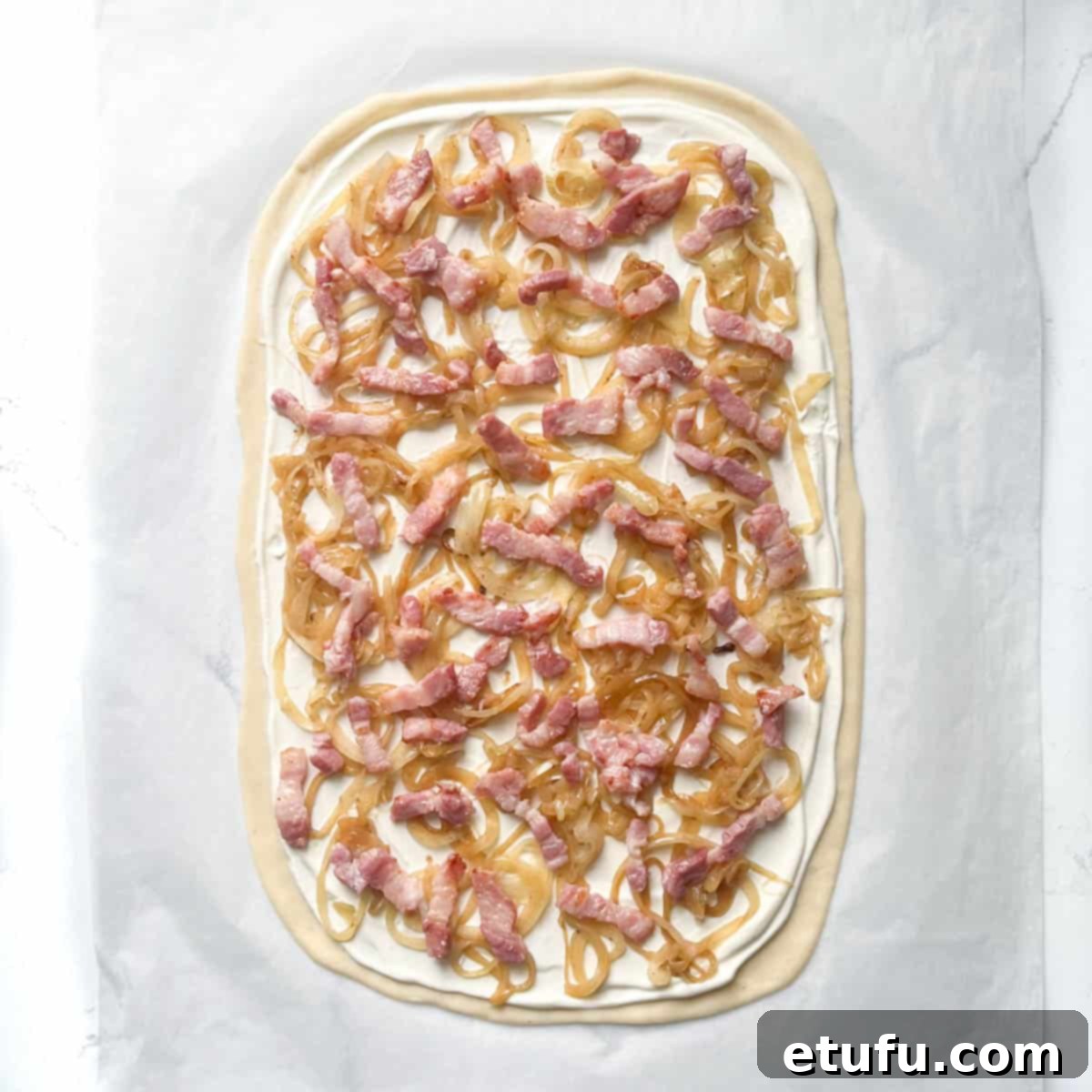
- Next, spread the pre-fried bacon lardons evenly across the onions.

- Finally, lightly scatter the grated Gruyère cheese over the top. Remember, less is more with the cheese to maintain the Flammkuchen’s delicate nature.
Step 3: Baking and Serving Your Flammkuchen
The final step is quick and crucial for achieving that characteristic crispiness.
- Carefully remove the preheated hot baking tray or pizza stone from the oven. Gently slide the prepared Flammkuchen, still on its parchment paper, directly onto the hot tray. Be extremely cautious to avoid burns.
- Bake for **15-16 minutes**. Keep a close eye on your Flammkuchen; it’s ready when the cheese is perfectly melted and bubbling, the crust has turned a light golden brown, and you see a few deliciously scorched bits here and there.
Important Note: Baking times are approximate. Ovens vary, so your Flammkuchen might cook faster or slower. Trust your instincts and the visual cues described above to determine when it’s perfectly done.
- Once baked, carefully remove the Flammkuchen from the oven. Scatter some freshly chopped chives, a grind of black pepper, or your favorite fresh herbs over the top for an extra layer of flavor and visual appeal. Cut into traditional rectangular slices or wedges and serve immediately while hot and crispy. Enjoy your homemade taste of Alsace!
Endless Creativity: Inspiring Flammkuchen Topping Variations
While the classic Flammkuchen with bacon, onion, and cream is undeniably delicious, its simple base lends itself beautifully to a myriad of creative topping combinations. Unleash your inner chef and explore these exciting variations, transforming your Flammkuchen into a personalized culinary masterpiece:
- Mushroom and Thyme: A rustic combination of earthy sautéed mushrooms and aromatic fresh thyme.
- Vegetarian Garden: Load it with vibrant grilled or roasted vegetables such as thinly sliced zucchini (courgettes), tender eggplant (aubergine), and sweet red peppers.
- Sweet Apple and Cinnamon: For a delightful dessert or brunch option, use thinly sliced apples, a sprinkle of cinnamon, and a drizzle of honey or maple syrup.
- Ham and Emmental: A straightforward yet satisfying choice with thin slices of cooked ham and grated Emmental cheese.
- Smoked Salmon and Dill: A sophisticated pairing of delicate smoked salmon and fragrant fresh dill, best added after baking.
- Goat Cheese and Honey: Crumbled goat cheese, a generous drizzle of honey, and thinly sliced red onions for a sweet and tangy profile.
- Asparagus and Prosciutto: Blanched asparagus spears wrapped in savory prosciutto, offering a burst of fresh and salty flavors.
- Potato and Rosemary: Ultra-thinly sliced potatoes (par-cooked if desired) and fresh rosemary for a hearty, aromatic option.
- Black Olive and Feta: Briny black olives, crumbled feta cheese, and a hint of red onion create a Mediterranean twist.
- Fresh Tomato and Basil: Simple, vibrant slices of fresh ripe tomatoes and aromatic basil leaves, a nod to Italian flavors.
- Spicy Sausage and Jalapeño: Kick up the heat with sliced spicy sausage and diced jalapeño peppers for a fiery experience.
- Fig and Prosciutto: A gourmet combination of sweet fresh fig slices, savory prosciutto, and creamy goat cheese.
- Three Cheese Blend: Indulge in a mix of grated Parmesan, nutty Gruyère, and melty mozzarella for ultimate cheese lovers.
- Shrimp and Garlic: Succulent shrimp, minced garlic, and fresh chopped parsley for a seafood delight.
- Smoked Bacon and Egg: Thinly sliced smoked bacon with a cracked egg baked directly onto the Flammkuchen until set – perfect for breakfast or brunch.
- Pear and Blue Cheese: Sweet sliced pears, pungent crumbled blue cheese, and crunchy walnuts create a sophisticated flavor pairing.
- Ratatouille: A medley of beautifully sautéed eggplant, zucchini (courgettes), bell peppers, and onions, capturing the essence of Provence.
- Chicken and Pesto: Shredded cooked chicken and fragrant dollops of basil pesto for a flavorful and easy topping.
- Caramelized Onion and Gouda: Double down on the sweetness with thinly sliced caramelized onions and rich, grated Gouda cheese.
- Tuna and Red Pepper: Flaked canned tuna, sweet roasted red peppers, and salty capers for a unique combination.
- Artichoke and Spinach: Chopped artichoke hearts, sautéed spinach, and grated Parmesan cheese for a savory, earthy option.
- BBQ Chicken: Shredded BBQ chicken, thinly sliced red onion, and fresh coriander for a smoky, sweet, and tangy profile.
- Sausage and Sauerkraut: A hearty German-inspired pairing of sliced cooked sausage and tangy sauerkraut.
- Roasted Beet and Goat Cheese: Earthy roasted beet slices, creamy crumbled goat cheese, and chopped fresh chives for a vibrant, flavorful dish.
- Caprese: Classic Italian flavors with fresh tomato slices, creamy fresh mozzarella, and aromatic basil leaves.
- Corn and Cheddar: Sweet cooked corn kernels and sharp grated cheddar cheese for a family-friendly favorite.
- Caramelized Fennel and Ricotta: Delicate, thinly sliced caramelized fennel with dollops of creamy ricotta cheese.
- Blueberry and Brie: A surprisingly delicious sweet-savory blend of fresh blueberries, melted sliced brie cheese, and a honey drizzle.
- Pesto and Sun-Dried Tomato: A base of vibrant pesto sauce topped with intensely flavorful chopped sun-dried tomatoes.
- Bacon and Brussels Sprouts: Earthy sautéed Brussels sprouts paired with crispy crumbled bacon for a unique and savory twist.
The possibilities are truly endless, allowing you to tailor your Flammkuchen to seasonal ingredients, personal preferences, or specific dietary needs.
Perfect Pairings: What to Serve with Flammkuchen
Flammkuchen, with its rich and savory flavors, is a meal in itself, but it truly shines when accompanied by thoughtfully chosen sides. These additions enhance the dining experience, offering balance and freshness.
- Crisp Green Salad: A simple, fresh green salad is the quintessential accompaniment. Its lightness and vibrant flavors cut through the richness of the Flammkuchen beautifully. Opt for mixed greens, cherry tomatoes, and cucumber dressed with a light vinaigrette. Our simple Jerusalem salad would be an excellent choice.
- Tangy Pickles: Pickles, such as gherkins (cornichons) or pickled onions, are a traditional and highly popular pairing. Their sharp, tangy, and crunchy texture provides a fantastic contrast to the creamy, savory Flammkuchen.
- Fresh Radishes: Thinly sliced radishes offer a refreshing and subtly spicy crunch. Serve them alongside your Flammkuchen or scatter them on top as a garnish for an extra layer of flavor and texture.
- Cool Cucumber and Greek Yogurt Dip: A cool and creamy dip, similar to tzatziki, can offer a delightful refreshing contrast. Its cooling effect can balance the warmth and richness of the Flammkuchen. Serve it on the side for dipping or drizzle a little over each slice.
- Elegant White Wine: To truly embrace the Alsatian tradition, pair your Flammkuchen with a crisp and dry white wine. Excellent choices include a Riesling, Pinot Blanc, or Pinot Gris, which complement the dish’s flavors without overpowering them.
These serving suggestions ensure a well-rounded and authentic Flammkuchen dining experience, perfect for sharing with friends and family.
Storing and Reheating Your Flammkuchen
Flammkuchen is undeniably at its peak when served piping hot and fresh from the oven, offering maximum crispness and flavor. However, if you find yourself with delightful leftovers, they can certainly be saved and enjoyed again.
- Storage: Any leftover Flammkuchen should be stored in an airtight container in the refrigerator. It will keep well for up to 3 days, ensuring you can savor its flavors later.
- Reheating: To bring your Flammkuchen back to life, preheat your oven to 200℃ (390℉ / Gas Mark 6). Place the cold slices directly on a baking sheet and bake for approximately 8-10 minutes, or until thoroughly heated through and the crust has regained some of its crispness. Avoid microwave reheating, as it will make the crust soggy.
Freezing Flammkuchen for Future Enjoyment
Yes, Flammkuchen is a fantastic candidate for freezing, making it an excellent option for meal prep or having a quick, delicious meal ready to go. You have a couple of convenient options for freezing:
- Freezing Unbaked with Toppings: You can prepare the Flammkuchen base and add all the toppings (excluding fresh herbs, which are best added after baking) and then freeze it unbaked. Place the entire topped Flammkuchen on a piece of parchment paper on a flat surface in the freezer until solid. Once frozen, you can wrap it tightly in plastic wrap and then foil, and store it for up to three months.
- To Cook from Frozen: Remove the frozen Flammkuchen from the freezer a few hours before baking to allow it to thaw slightly, if possible. If baking directly from frozen, add an extra couple of minutes to the usual baking time (e.g., 18-20 minutes). Bake at 240℃ (465℉ / Gas Mark 8) until golden brown and crispy.
- Freezing the Base Only: Alternatively, you can prepare the dough, roll it out thinly, and then freeze the raw base by itself. Wrap it securely in plastic wrap and foil. It will keep in the freezer for up to three months.
- To Cook from Frozen Base: Thaw the frozen base completely. Add your desired toppings (crème fraîche, onions, bacon, Gruyère). Then bake at 240℃ (465℉ / Gas Mark 8) for 15-16 minutes, or until the cheese is melted, the toppings are cooked, and the crust is beautifully crisp and golden brown with a few scorched edges.
Freezing Flammkuchen is a wonderful way to enjoy this authentic Alsatian dish even on your busiest days.
Explore More Delicious Pastry Recipes
If you enjoyed the simplicity and deliciousness of our Flammkuchen recipe, you might be keen to explore more delightful pastry-based creations. From savory pies to innovative twists on classic dishes, these recipes promise to inspire your next kitchen adventure:
- Unique Bacon and Feta Pizza
- Hearty Creamy Chicken and Leek Pies with Puff Pastry
- Classic Cheese and Onion Pasties
- Easy Chicken Mince Sausage Rolls
- Flavorful Mini Butter Chicken Pies
- Gourmet Mini Homemade Sausage Rolls with Puff Pastry
Discover More Irresistible Pizza Creations
For those who simply can’t get enough of pizza in all its glorious forms, we have more exciting recipes that push the boundaries of what pizza can be. Dive into these unique and flavorful ideas:
- Easy Bacon Pizza with Creamy Avocado and Feta Cheese
- Quick and Easy Pizza Toast with 5 Topping Ideas
- The Mighty Meatzza: An All-Meat Crust Pizza Adventure
Complementary Sides for Your Flammkuchen Feast
- Simple Jerusalem Salad (Israeli Salad)
- Crispy Crumbed Mushrooms Recipe
- Panzanella Toscana Salad – Italian Bread Salad
- Rainbow Salad with Chinese-Inspired Dressing
The Best Beverages to Pair with Flammkuchen
Choosing the right beverage can elevate your Flammkuchen experience, complementing its rich flavors and crisp texture. In Alsace, specific drinks are traditionally favored:
- White Wine: Traditionally, a dry white wine from the Alsace region is the top choice. Varieties like a dry Riesling, a crisp Pinot Blanc, or a full-bodied Pinot Gris are excellent pairings, as their acidity and fruit notes beautifully cut through the richness of the cream and bacon.
- Beer: For beer enthusiasts, a light and crisp lager or a refreshing pilsner can also be a wonderful match, especially with its savory, bready qualities.
- Cider: A dry hard cider offers a tart and refreshing counterpoint that works surprisingly well with the savory flavors of Flammkuchen.
- Sparkling Water: For a non-alcoholic option, sparkling water with a twist of lemon or lime provides a refreshing palate cleanser that keeps the focus on the delicious food.
Whatever your preference, selecting a drink that complements the rustic charm of Flammkuchen will enhance your enjoyment of this unique dish.
Easy Flammkuchen (French-German Pizza) Recipe

Easy Flammkuchen – French-German Pizza
Print Recipe
Equipment
- 1 large baking sheet
- Parchment paper
- 1 large lidded frying pan
Ingredients
For the Flammkuchen Base
- 250 grams all-purpose flour
- ½ teaspoon salt
- 125 millilitre warm water – warm tap water, not boiled from a kettle
- 2 tablespoons olive oil
Toppings
- 180 grams smoked bacon lardons – or regular bacon, cubed
- 1 large onion – finely sliced into rings
- 1 teaspoon brown sugar
- 50 grams crème fraîche
- 50 grams sour cream
- 40 grams Gruyère cheese – grated
- chives or herbs of choice for scattering over pizza
Instructions
To Make the Flammkuchen Base
- Preheat the oven to 240℃/465℉/gas mark 8. Place a large baking tray on the middle shelf of the oven to heat up with the oven.
- Add the flour and salt to the bowl of a stand mixer. If you are not using a stand mixer, add it to a large mixing bowl. Give it a quick stir.
- Add the warm water and the olive oil to the flour and briefly combine using a spoon.
- If you are using a stand mixer, attach the dough hook and knead the dough for 8-10 minutes.
If you are doing this by hand, knead for a good 10 minutes until the dough is elastic and smooth.
- Cut a piece of parchment paper the same size as the baking tray and place it on the work surface.
- Place the pizza dough on the parchment paper. With a rolling pin, roll it into a thin oblong disc of 3mm – 5mm thick.
Preparing the Toppings
- Add the bacon lardons to a hot frying pan and briefly fry until they just start to brown.
Don’t fry them too long because they will cook further in the oven. It should only take about 2 minutes. Remove from the pan.
- In the same pan, add a dollop of butter, or a dash of oil, along with the thinly sliced onion rings.
Turn the heat to medium-low and place the lid on. Allow the onions to soften, about 3-4 minutes.
Stir every minute or so to ensure they are not sticking to the pan.
- When the onions are soft, add the teaspoon of brown sugar. Fry for a further 1-2 minutes, lid off, until the onions are a light golden brown, soft and caramelised.
- In a small bowl, mix together the crème fraîche and sour cream.
Evenly spread it across the surface of the pizza dough, leaving a gap of roughly 1cm from the edge.
- Start by topping the pizza with the caramelised onions. Then top with the bacon lardons, spreading them out evenly. Scatter over the grated Gruyère cheese.
- Remove the hot baking tray from the oven and slide the pizza along with the parchment paper onto the tray.
Take care not to burn yourself. Bake for 15-16 minutes until the cheese is melted and the crust is a light golden brown, with a few scorched bits here and there.
Important: Keep an eye on the pizza. The baking time is an approximation. All ovens are slightly different and you may get a different result with yours. Cook the pizza until it looks done, using the above visual clues.
- Scatter some chopped chives or your favorite herbs over the top of the pizza. Cut into slices and enjoy immediately.
**Nutritional Data Disclaimer**
Please keep in mind that the nutritional information provided below is calculated by a third party and we cannot guarantee its absolute accuracy. While we strive to provide the most precise information possible, we do not take responsibility for any errors that may be present. Furthermore, the nutritional value of the recipe can vary depending on the exact brands and products used in your preparation. We strongly recommend consulting with a qualified healthcare professional or a registered dietitian for personalized advice regarding your specific dietary needs.
Nutrition
For important food safety advice, including comprehensive guidance on food allergies, please refer to this resource.
